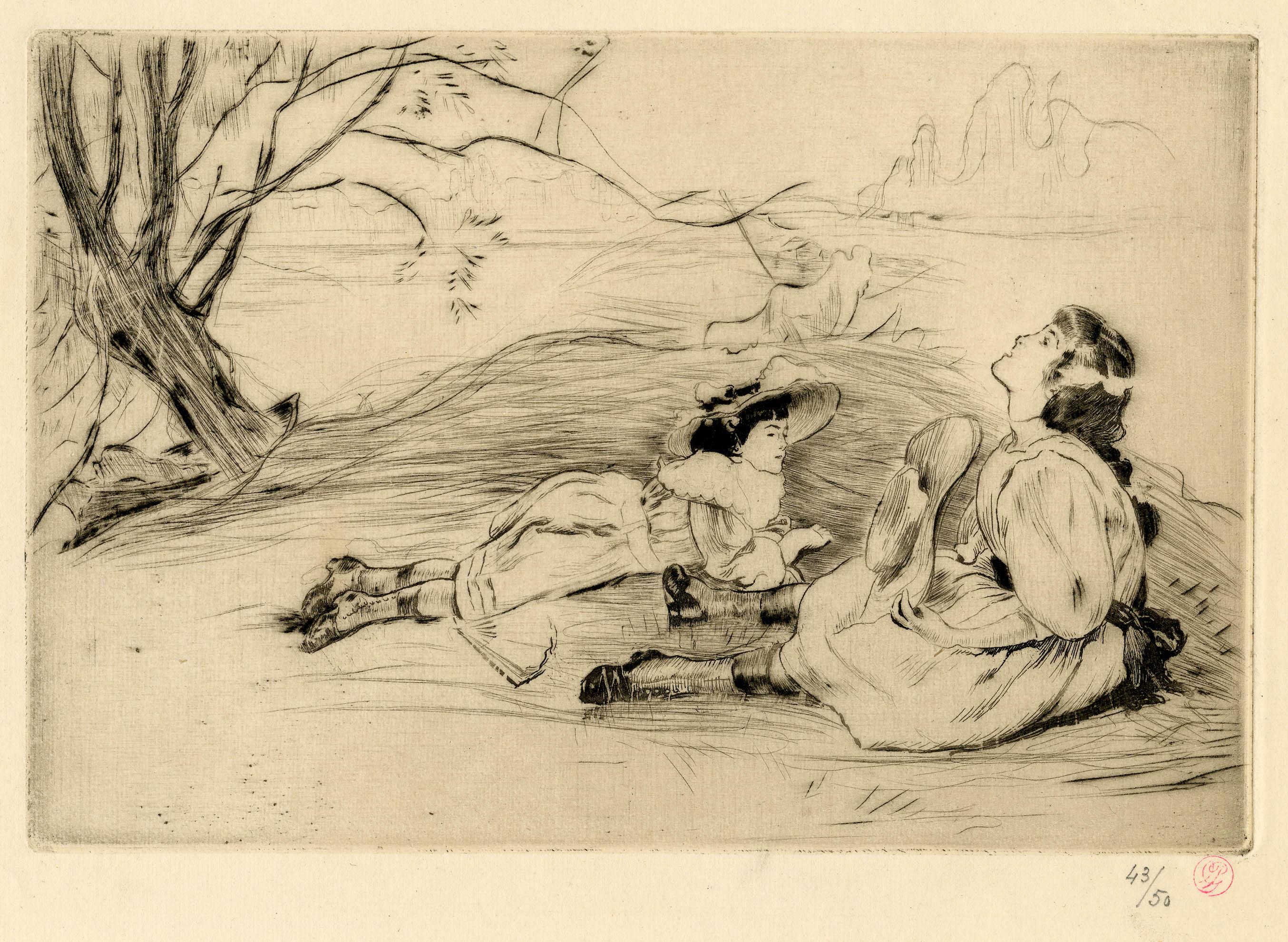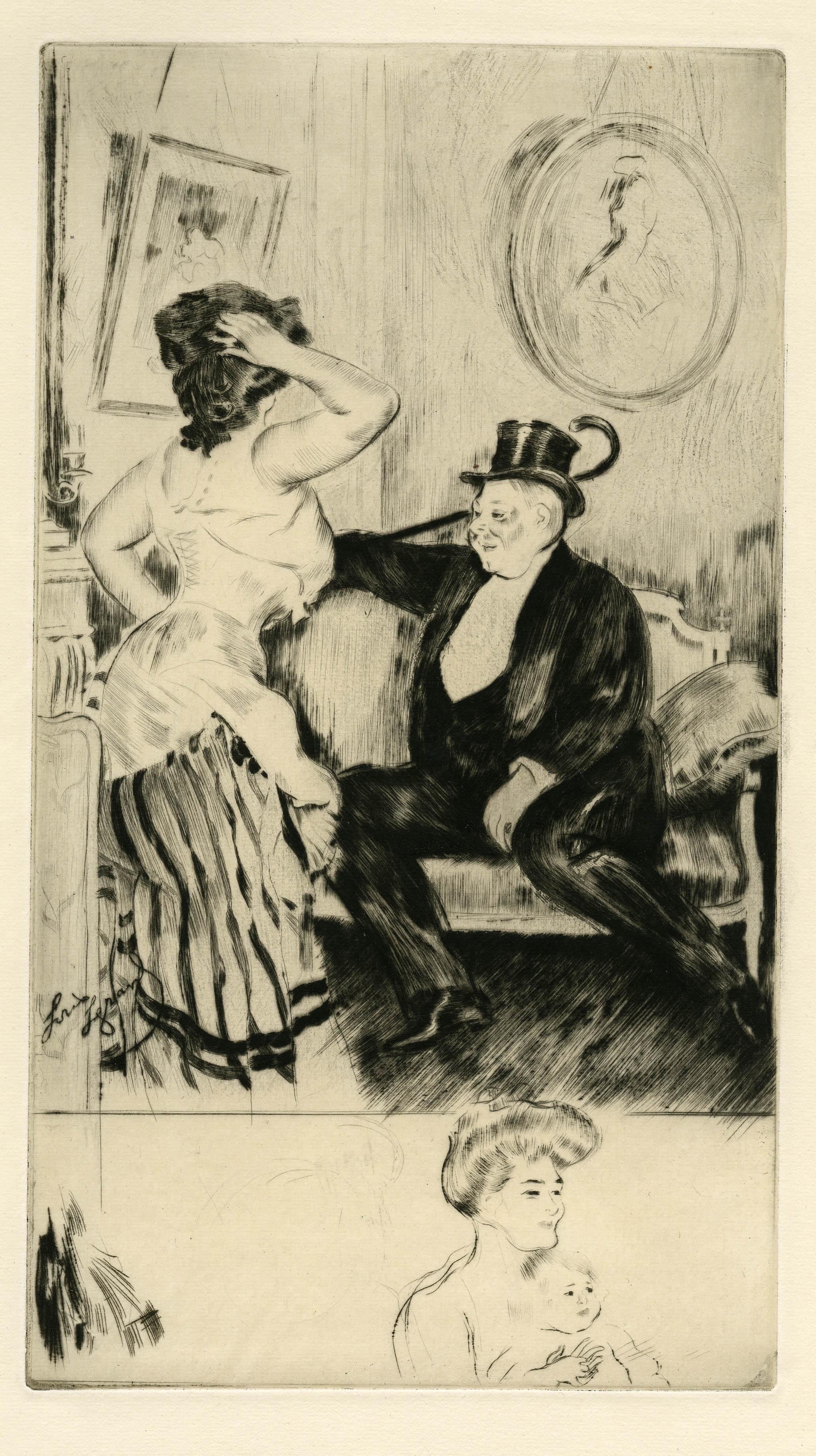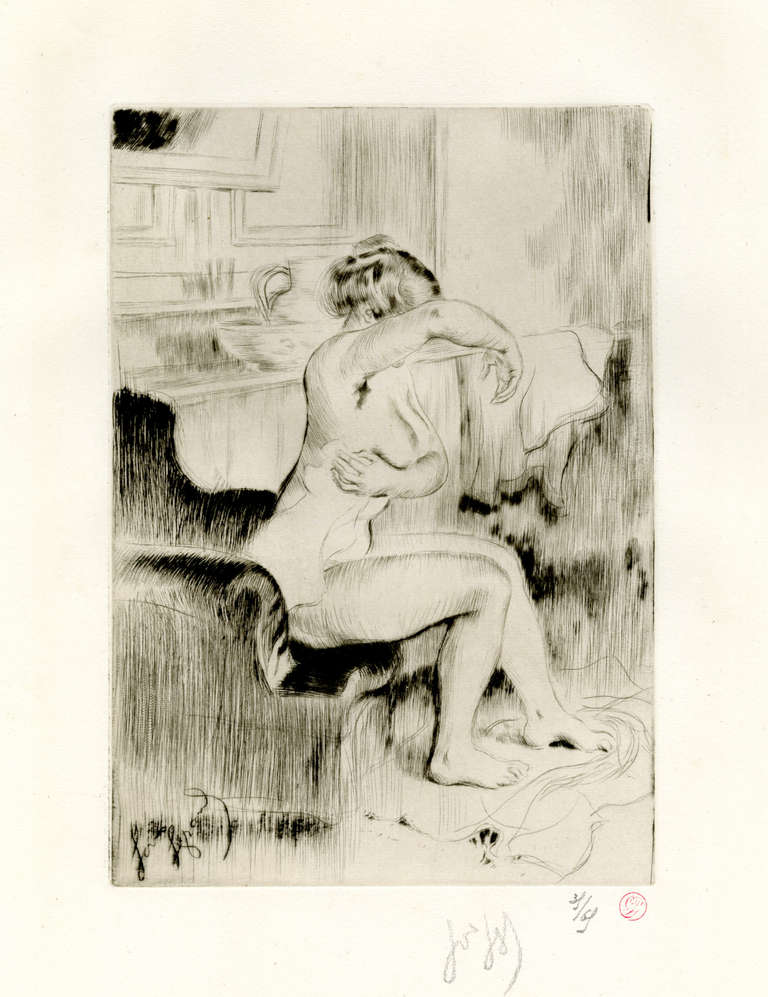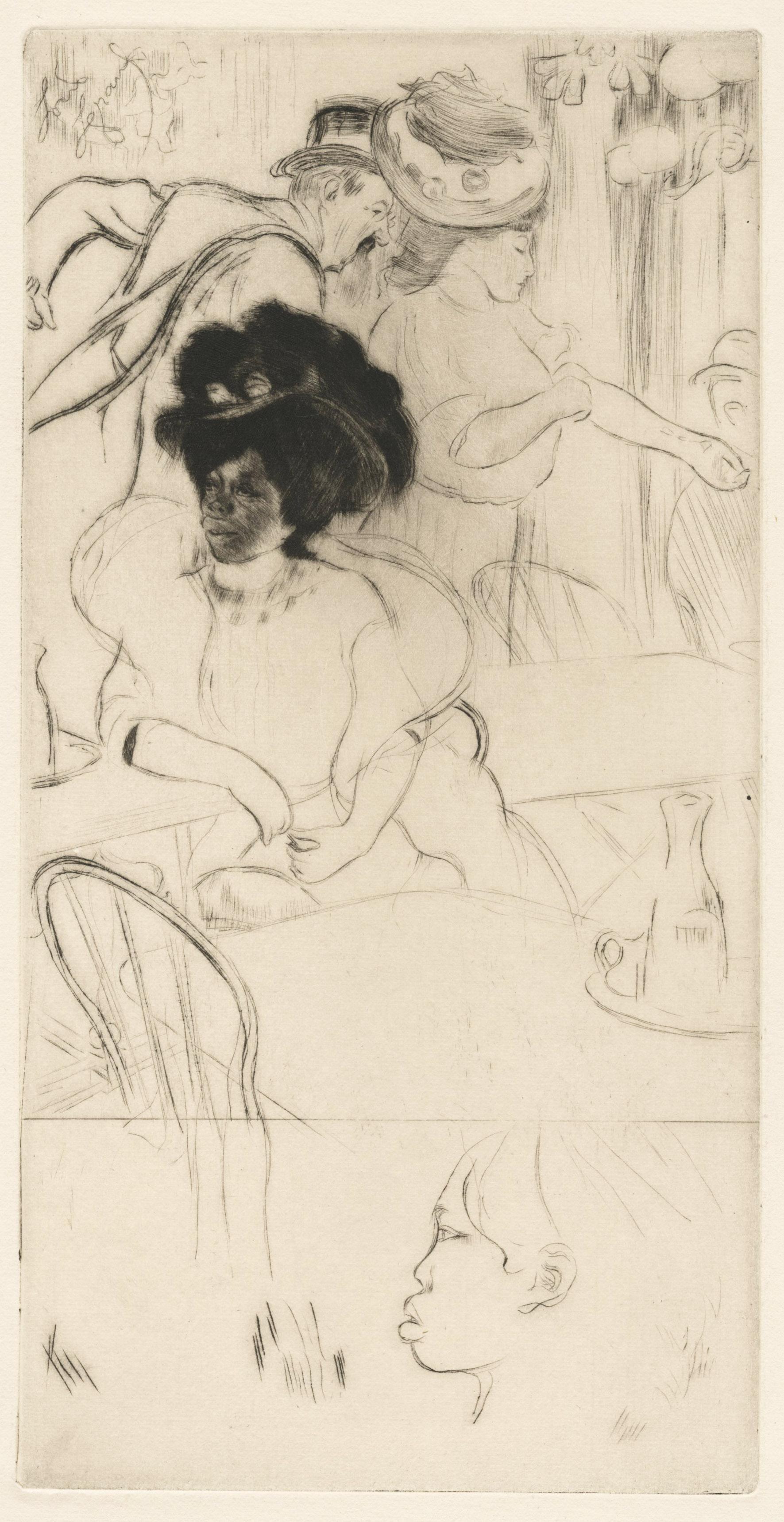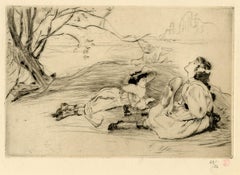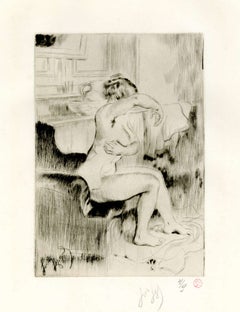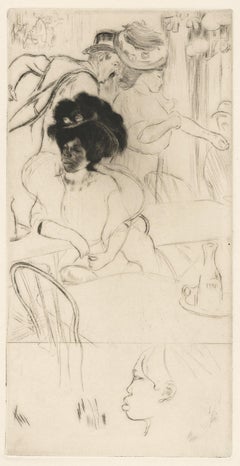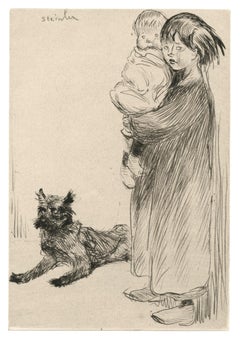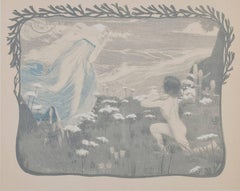Items Similar to L'Aieule (The Grandmother)
Want more images or videos?
Request additional images or videos from the seller
1 of 10
Louis LegrandL'Aieule (The Grandmother)1904
1904
$950
£719.81
€825.92
CA$1,336.80
A$1,469.51
CHF 772.31
MX$17,845.26
NOK 9,634.37
SEK 9,127.89
DKK 6,164.05
About the Item
L'Aieule (The Grandmother)
Etching and aquatint printed in colors, 1904
Signed with the red stamp of the publisher, Gustave Pellet, Lugt 1193 and numbered (see photo)
Edition: 100 (81/100)
Reference: Arwas 202 iv/IV
IFF 98
Condition: Excellent, the sheet aged as usual
Image size: 14 1/4 x 18 5/8"
Sheet size: 16 15/16 x 24 1/4"
Louis Auguste Mathieu Legrand (29 September 1863 – 1951) was a French artist, known especially for his aquatint engravings, which were sometimes erotic. He was awarded the Légion d'honneur for his work in 1906.
Life
Legrand was born in the city of Dijon in the east of France. He worked as a bank clerk before deciding to study art part-time at Dijon's Ecole des Beaux-Arts. He won the Devosge prize at the school in 1883.[2] In 1884 Legrand studied engraving under the Belgian printmaker Félicien Rops.
Legrand's artworks include etchings, graphic art and paintings. His paintings featured Parisian social life. Many were of prostitutes, dancers and bar scenes, which featured a sense of eroticism. According to the Hope Gallery, "Louis Legrand is simply one of France's finest early twentieth century masters of etching." His black and white etchings especially provide a sense of decadence; they have been compared to those of Henri de Toulouse-Lautrec, though his drawings of the Moulin Rouge, the can-can dance and the young women of Montmartre preceded Toulouse-Lautrec's paintings of similar scenes. He made over three hundred prints of the night life of Paris. They demonstrate "his remarkable powers of observation and are executed with great skill, delicacy, and an ironic sense of humor that pervades them all."
Two of his satirical artworks caused him to be tried for obscenity. The first, "Prostitution" was a symbolic drawing which depicted a naked girl being grasped by a dark monster which had the face of an old woman and claws on its hands; the second, "Naturalism", showed the French novelist Émile Zola minutely studying the thighs of a woman with a magnifying glass. Defended by his friend the lawyer Eugène Rodrigues-Henriques (1853–1928), he was found not guilty in the lower court, but was convicted in the appeal court and then given a short prison sentence for refusing to pay his fine.
Legrand was made famous by his colour illustrations for Gil Blas magazine's coverage of the can-can, with text by Rodrigues (who wrote under the pseudonym Erastene Ramiro). It was a tremendous success, with the exceptional quantity of 60,000 copies of the magazine being printed and instantly sold out in 1891.
In 1892, at the instigation of the publishing house Dentu, Legrand made a set of etchings of his Gil Blas illustrations. The etchings were published in a book, Le Cours de Danse Fin de Siecle (The End of the Century Dance Classes).
Legrand took a holiday in Brittany, which inspired him to engrave a set of fourteen lithographs of simple country life called Au Cap de la Chevre (On Goat Promontory). It was published by Gustave Pellet who became a close friend of Legrand's. Pellet eventually published a total of 300 etchings by Legrand, who was his first artist; he also published Toulouse-Lautrec and Félicien Rops among others.
He did not only work in graphics; he exhibited paintings at the Paris salon of the Société Nationale des Beaux-Arts starting in 1902. In 1906 he was made a chevalier of the Légion d'honneur.
Legrand died in obscurity in 1951. A retrospective exhibition was held at the Félicien Rops museum in Namur, Belgium in 2006 to celebrate his graphic art. The art collector Victor Arwas published a catalogue raisonné for the occasion.
Books illustrated
de Maupassant, Guy: Cinq Contes Parisiens, 1905.
Poe, Edgar Alan: Quinze Histoires d'Edgar Poe, 1897.
Awards and exhibitions
1896: First solo exhibition, Paris.
1900: Silver Medal, Universal Exhibition, Paris.
1906: Légion d'honneur.
1911: Retrospective exhibition, Palais de Modes, Paris.
2006: Retrospective exhibition, Félicien Rops museum, Namur, Belgium.
Works in collections
Joie Maternelle ("Maternal Joy"), 1900, Yale Medical Historical Library.
Titi. Brooklyn Museum.
See also
Martin van Maële
References
Louis Legrand : catalogue raisonne, Victor Arwas and the Musée Félicien Rops (Namur, Belgium), Papadakis, London, 2006
Arwas, Victor (1978). "Louis Legrand". Armstrong Fine Art. Retrieved 2013-05-10.
"Exhibit Invite #1 (etching)". Hope Gallery. 2007–2013. Retrieved 2013-05-11.
"Louis Legrand (1863-1951)". Fletcher/Copenhaver Fine Art. Retrieved 2013-05-12.
Not, as often reported, in 1902. Louis Legrand: catalogue raisonné, Victor Arwas and the Musée Félicien Rops (Namur, Belgium), Papadakis, London, 2006
Arwas, 2006.
Yale: Medical Historical Library Archived 2011-06-23 at the Wayback Machine
"Brooklyn Museum: European Art: Titi".
Bibliography
Arwas, Victor. Belle Époque: Louis Legrand. New York, 1978.
Arwas, Victor. Louis Legrand: Catalogue Raisonné. Papadakis, 2006.
Kahn, Gustave. Louis Legrand. Special issue of "L'Art et le Beau" magazine, 1908.
Mauclair, Camille. Études sur quelques artistes originaux. Louis Legrand, peintre et graveur. Paris, 1910.
Courtesy Wikipedia
- Creator:Louis Legrand (1863 - 1951, French)
- Creation Year:1904
- Dimensions:Height: 14.25 in (36.2 cm)Width: 18.63 in (47.33 cm)
- Medium:
- Movement & Style:
- Period:
- Condition:
- Gallery Location:Fairlawn, OH
- Reference Number:Seller: FA96251stDibs: LU14011326542
Louis Legrand
Louis Legrand was born in Dijon, France, on September 29, 1863. He worked as a bank teller and studied art at the Dijon Ecole des Beaux-Arts in his spare time. At the age of 20, he won the Devosge prize at that school and a year later left for Paris. Legrand arrived in Paris in 1884, where he studied under Felicien Rops and soon became famous for his paintings, drawings and etchings depicting the Parisian beau-monde. A superb draughtsman, his etchings also show great sophistication. Legrand's prints were almost all published by Gustave Pellet, who published many erotic images.
About the Seller
5.0
Recognized Seller
These prestigious sellers are industry leaders and represent the highest echelon for item quality and design.
Platinum Seller
Premium sellers with a 4.7+ rating and 24-hour response times
Established in 1978
1stDibs seller since 2013
813 sales on 1stDibs
Typical response time: <1 hour
Associations
International Fine Print Dealers Association
- ShippingRetrieving quote...Shipping from: Fairlawn, OH
- Return Policy
Authenticity Guarantee
In the unlikely event there’s an issue with an item’s authenticity, contact us within 1 year for a full refund. DetailsMoney-Back Guarantee
If your item is not as described, is damaged in transit, or does not arrive, contact us within 7 days for a full refund. Details24-Hour Cancellation
You have a 24-hour grace period in which to reconsider your purchase, with no questions asked.Vetted Professional Sellers
Our world-class sellers must adhere to strict standards for service and quality, maintaining the integrity of our listings.Price-Match Guarantee
If you find that a seller listed the same item for a lower price elsewhere, we’ll match it.Trusted Global Delivery
Our best-in-class carrier network provides specialized shipping options worldwide, including custom delivery.More From This Seller
View AllA L'Ombre (In Shadow)
By Louis Legrand
Located in Fairlawn, OH
A L'Ombre (In Shadow)
Etching & drypoint, 1905
Signed with the red stamp of the publisher Pellet (see photo)
Edition: 50 on velin paper, signed and numbered
Publisher: Gustav Pellet, Paris (his red stamp lower right, recto; Lugt 1193)
Condition: Excellent
Image/Plate size: 5-7/8 x 8-5/8" (14.8 x 21.8 cm.)
Sheet size: 11 5/8 x 17 1/8"
Reference: IFF 119
Exteens 229
Arwas 256 v/V
Louis Auguste Mathieu Legrand (29 September 1863 – 1951) was a French artist, known especially for his aquatint engravings, which were sometimes erotic. He was awarded the Légion d'honneur for his work in 1906.
Life
Legrand was born in the city of Dijon in the east of France. He worked as a bank clerk before deciding to study art part-time at Dijon's Ecole des Beaux-Arts. He won the Devosge prize at the school in 1883.[2] In 1884 Legrand studied engraving under the Belgian printmaker Félicien Rops.
Legrand's artworks include etchings, graphic art and paintings. His paintings featured Parisian social life. Many were of prostitutes, dancers and bar scenes, which featured a sense of eroticism. According to the Hope Gallery, "Louis Legrand is simply one of France's finest early twentieth century masters of etching." His black and white etchings especially provide a sense of decadence; they have been compared to those of Henri de Toulouse-Lautrec, though his drawings of the Moulin Rouge, the can-can dance and the young women of Montmartre preceded Toulouse-Lautrec's paintings of similar scenes. He made over three hundred prints of the night life of Paris. They demonstrate "his remarkable powers of observation and are executed with great skill, delicacy, and an ironic sense of humor that pervades them all."
Two of his satirical artworks caused him to be tried for obscenity. The first, "Prostitution" was a symbolic drawing which depicted a naked girl being grasped by a dark monster which had the face of an old woman and claws on its hands; the second, "Naturalism", showed the French novelist Émile Zola minutely studying the thighs of a woman with a magnifying glass. Defended by his friend the lawyer Eugène Rodrigues-Henriques (1853–1928), he was found not guilty in the lower court, but was convicted in the appeal court and then given a short prison sentence for refusing to pay his fine.
Legrand was made famous by his colour illustrations for Gil Blas magazine's coverage of the can-can, with text by Rodrigues (who wrote under the pseudonym Erastene Ramiro). It was a tremendous success, with the exceptional quantity of 60,000 copies of the magazine being printed and instantly sold out in 1891.
In 1892, at the instigation of the publishing house Dentu, Legrand made a set of etchings of his Gil Blas illustrations. The etchings were published in a book, Le Cours de Danse Fin de Siecle (The End of the Century Dance Classes).
Legrand took a holiday in Brittany, which inspired him to engrave a set of fourteen lithographs of simple country life called Au Cap de la Chevre (On Goat Promontory). It was published by Gustave Pellet who became a close friend of Legrand's. Pellet eventually published a total of 300 etchings by Legrand, who was his first artist; he also published Toulouse-Lautrec and Félicien Rops among others.
He did not only work in graphics; he exhibited paintings at the Paris salon of the Société Nationale des Beaux-Arts starting in 1902. In 1906 he was made a chevalier of the Légion d'honneur.
Legrand died in obscurity in 1951. A retrospective exhibition was held at the Félicien Rops museum in Namur, Belgium in 2006 to celebrate his graphic art. The art collector Victor Arwas published a catalogue raisonné for the occasion.
Books illustrated
de Maupassant, Guy: Cinq Contes Parisiens, 1905.
Poe, Edgar Alan: Quinze Histoires d'Edgar Poe...
Category
Early 1900s Art Nouveau Landscape Prints
Materials
Etching
En passant (Passing by)
By Louis Legrand
Located in Fairlawn, OH
En passant (Passing by)
Drypoint, 1909
Unsigned (as issued in the deluxe portfolio)
From the album "Les Bars" (8 plates plus cover illustration)
Edition: 30, this state with remarque
Published by Gustav Pellet, Paris
A very rich impression wwith burr
Condition: Excellent
Image/Plate size: 9 7/8 x 6 3/8 inches
Reference: Arwas 391a (remarque)
Exteens 277 i/II
IFF 148 (portfolio)
Louis Auguste Mathieu Legrand (29 September 1863 – 1951) was a French artist, known especially for his aquatint engravings, which were sometimes erotic. He was awarded the Légion d'honneur for his work in 1906.
Life
Legrand was born in the city of Dijon in the east of France. He worked as a bank clerk before deciding to study art part-time at Dijon's Ecole des Beaux-Arts. He won the Devosge prize at the school in 1883.[2] In 1884 Legrand studied engraving under the Belgian printmaker Félicien Rops.
Legrand's artworks include etchings, graphic art and paintings. His paintings featured Parisian social life. Many were of prostitutes, dancers and bar scenes, which featured a sense of eroticism. According to the Hope Gallery, "Louis Legrand is simply one of France's finest early twentieth century masters of etching." His black and white etchings especially provide a sense of decadence; they have been compared to those of Henri de Toulouse-Lautrec, though his drawings of the Moulin Rouge, the can-can dance and the young women of Montmartre preceded Toulouse-Lautrec's paintings of similar scenes. He made over three hundred prints of the night life of Paris. They demonstrate "his remarkable powers of observation and are executed with great skill, delicacy, and an ironic sense of humor that pervades them all."
Two of his satirical artworks caused him to be tried for obscenity. The first, "Prostitution" was a symbolic drawing which depicted a naked girl being grasped by a dark monster which had the face of an old woman and claws on its hands; the second, "Naturalism", showed the French novelist Émile Zola minutely studying the thighs of a woman with a magnifying glass. Defended by his friend the lawyer Eugène Rodrigues-Henriques (1853–1928), he was found not guilty in the lower court, but was convicted in the appeal court and then given a short prison sentence for refusing to pay his fine.
Legrand was made famous by his colour illustrations for Gil Blas magazine's coverage of the can-can, with text by Rodrigues (who wrote under the pseudonym Erastene Ramiro). It was a tremendous success, with the exceptional quantity of 60,000 copies of the magazine being printed and instantly sold out in 1891.
In 1892, at the instigation of the publishing house Dentu, Legrand made a set of etchings of his Gil Blas illustrations. The etchings were published in a book, Le Cours de Danse Fin de Siecle (The End of the Century Dance Classes).
Legrand took a holiday in Brittany, which inspired him to engrave a set of fourteen lithographs of simple country life called Au Cap de la Chevre (On Goat Promontory). It was published by Gustave Pellet who became a close friend of Legrand's. Pellet eventually published a total of 300 etchings by Legrand, who was his first artist; he also published Toulouse-Lautrec and Félicien Rops among others.
He did not only work in graphics; he exhibited paintings at the Paris salon of the Société Nationale des Beaux-Arts starting in 1902. In 1906 he was made a chevalier of the Légion d'honneur.
Legrand died in obscurity in 1951. A retrospective exhibition was held at the Félicien Rops museum in Namur, Belgium in 2006 to celebrate his graphic art. The art collector Victor Arwas published a catalogue raisonné for the occasion.
Books illustrated
de Maupassant, Guy: Cinq Contes Parisiens, 1905.
Poe, Edgar Alan: Quinze Histoires d'Edgar Poe...
Category
Early 1900s Art Nouveau Interior Prints
Materials
Drypoint
La Toilette
By Louis Legrand
Located in Fairlawn, OH
La Toilette
Drypoint, 1908
Signed and numbered in pencil by the artist (see photos)
Edition: 65 this state (35/65)
Published by Gustave Pellet (1859-1919),...
Category
Early 1900s Art Nouveau Figurative Prints
Materials
Drypoint
La Negresse (The Negress)
By Louis Legrand
Located in Fairlawn, OH
La Negresse (The Negress)
Etching & drypoint, 1909
Unsigned (as issued in the portfolio)
From the album "Les Bars" (8 plates plus cover illustration)
Editi...
Category
Early 1900s Art Nouveau Interior Prints
Materials
Etching
L'Angellus
By Alfredo Müller
Located in Fairlawn, OH
L'Angellus
Etching, engraving and acquatint on Arches paper, 1902
Signed lower right by the artist (see photo)
This is a first state impression printed in a brown/black ink, one of ...
Category
Early 1900s Art Nouveau Figurative Prints
Materials
Etching
Mlle Sablon, musical actress
By Albert de Belleroche
Located in Fairlawn, OH
Mademoiselle Sablon, MUSCIAL ACTRESS
Lithograph, 1907
Unsigned
Provenance: estate of the artist
Reference: Belleroche No. K383
Albert Belleroche Log of lithographs, AB698
Edition: c. 10
Condition: excellent
Image size: 20 x 17 inches
Sheet size: 24 1/4 x 18 1/2 inches
Albert Gustavus de Belleroche, also known as Albert Belleroche, (22 October 1864 – 14 July 1944) was a Welsh-born painter and lithographer, who lived most of his childhood and his adulthood in Paris and England. He began as a painter, but at the turn of the century focused on lithography, for which he is most well-known. He was awarded the Chevalier de l’Ordre de Leopold by King Albert I of Belgium in 1933.
Early life
Albert de Belleroche, Lithograph of the artist's mother, Mrs. Harry Vane Milbank, circa 1900
Albert Gustavus De Belleroche was born on 22 October 1864 in Swansea. His parents were Brusseler Alice and Edward Charles, the Marquis de Belleroche, who died when he was three years old. His mother was the daughter of Desire Baruch. In March 1871, she married Harry Vane Millbank, the son of MP Frederick Milbank. He grew up in Paris and London and he used the surname Milbank until he was 30 years of age. He attained the title of count from his father's family of French Huguenot ancestry.
Career and personal life
La Danseuse (model Lili Grenier), circa 1890
In 1882, Belleroche studied briefly at Carolus-Duran's art school in Paris, preferring to study the masters like Johannes Vermeer and Sandro Botticelli at museums. He was a friend and studio-mate of John Singer Sargent in Paris and London, with the men making many sketches and paintings of each other. Some of the works that Sargent made of Belleroche are suggestive of an emotional relationship between the men and Belleroche may have been the love of Sargent's life. Dorothy Moss, an art historian, states "Sargent's portraits of Belleroche, in their sensuality and intensity of emotion, push the boundaries of what was considered appropriate interaction between men at this period." Belleroche was financially independent and did not need or desire to obtain work through commissions. Instead, he chose who he would paint, which included Japanese wrestler...
Category
Early 1900s Impressionist Portrait Prints
Materials
Lithograph
You May Also Like
L"Ame du Poete (The Soul of the Poet)
By Louis Legrand
Located in San Francisco, CA
This artwork titled "L'Ame du Poete (The Soul of the Poet)" 1901, is an original etching and aquatint by renown French artist Louis Auguste Mathieu Legrand, 1863-1951. Signed in the ...
Category
Early 20th Century Impressionist Figurative Prints
Materials
Etching, Aquatint
Soir d'octobre - original lithograph (1897/98)
By Ernest Joseph Laurent
Located in Paris, IDF
Ernest Laurent
Soir d'octobre
Original lithograph
Plate signed
1897/98
Printed on paper Vélin
Size 40 x 31 cm (c. 16 x 12")
INFORMATION : Published by 'Estampe Moderne, Paris, 18...
Category
1890s Art Nouveau Figurative Prints
Materials
Lithograph
"La grande sœur" original drypoint
By Théophile Alexandre Steinlen
Located in Henderson, NV
Medium: original etching and drypoint. Catalogue reference: Sanchez and Seydoux 1913-10. Printed in 1913 and published in Paris by Gazette des Beaux-Arts. Sheet size: 8 1/2 x 6 inche...
Category
1910s Portrait Prints
Materials
Etching
"H. L'Illusion (L'Estampe Moderne I), " Color Lithograph
By Henri Bellery-Desfontaines
Located in Milwaukee, WI
"H. L'Illusion (L'Estampe Moderne I)" is an original color lithograph by Henri Bellery-Desfontaines. This piece depicts a nude child before a dream-like woman in a blue translucent robe. This piece was published in the French Art Nouveau publication L'Estampe Moderne. Signed in plate.
15 3/4" x 12" art
Henri Bellery-Desfontaines , born with Paris in 1867 and dead the October 6th 1909, is a French Noveau artist Jack-of-All- Trades, who produced tables, illustrations, posters, lithographies, drawings of carpet, pieces of furniture and banknotes, and even dabbled with decoration & architecture.
In the 1900s, Paris was the perfect place for a group of young artists influenced by artistic currents like neogothic style or symbolism. Most of them started as painters and they switched later to decorative arts, attracted by the idea of an ever-present art, a lifeless art, a total art. Henri Bellery-Desfontaines was a member of this group and he started as as painter in Pierre-Victor Galland’s atelier. He entrusted him the decorative motifs which would frame Panthéon de Paris' drawings: Maillot, Bonnat, Humbert and specially Jean-Paul Laurens, who proposed him to join his atelier in l’École des Beaux-Arts de Paris. With him, he decorated l'Hôtel de Ville de Paris or Le Salon Lobau, Henri Bellery-Desfontaines is thought to have Luc-Olivier Merson (1846-1920) as a teacher.
During his years as a student, he started to illustrate magazines and books of tales and in 1895, Bellery-Desfontaines opted rapidly for illustration, probably due to financial problems, and he participated in magazines such as L’Image, L’Estampe Moderne or L’Almanach des Bibliophiles. This year, the Salon des Artistes Français hosted one of his design of tapestry.
From 1900 on, he gradually evolved toward an ambitious decorative artist, making tapestries and furniture for rich leaders and patrons. Bellery-Desfontaines was an important artist of his epoch, and he took part in numerous events like Bal de...
Category
1890s Art Nouveau Figurative Prints
Materials
Lithograph
"La grande sœur" original drypoint
By Théophile Alexandre Steinlen
Located in Henderson, NV
Medium: original etching and drypoint. Catalogue reference: Sanchez and Seydoux 1913-10. Printed in 1913 and published in Paris by Gazette des Beaux-Arts. Plate size: 8 3/4 x 6 1/8 i...
Category
1910s Portrait Prints
Materials
Etching
Il Ressemble à Ernest - Etching by Adolphe Willett - Late-19th century
By Adolphe Willette
Located in Roma, IT
Il Ressemble à Ernest is an Original Etching and Drypoint realized by Willette (Adolphe Leon).
Good condition on a yellowed paper.
signed on plate on the lower left corner and titl...
Category
19th Century Art Nouveau Figurative Prints
Materials
Etching
More Ways To Browse
Antique Magnifying Glasses
Tom Wesselmann Signed
Tool Posters
Vintage Cardinal Print
70s Pop Art
Aaron Douglas
Alfons Mucha
American Brilliant Cut Glass Plate
Andy Warhol Announcement Card
Antique Manga
Antique Poupee
Antique Star Chart
Burt Lancaster
Chagall 1967
Chagall Lion
Chagall Rachel
Charles Leandre
Dali Beatrice
